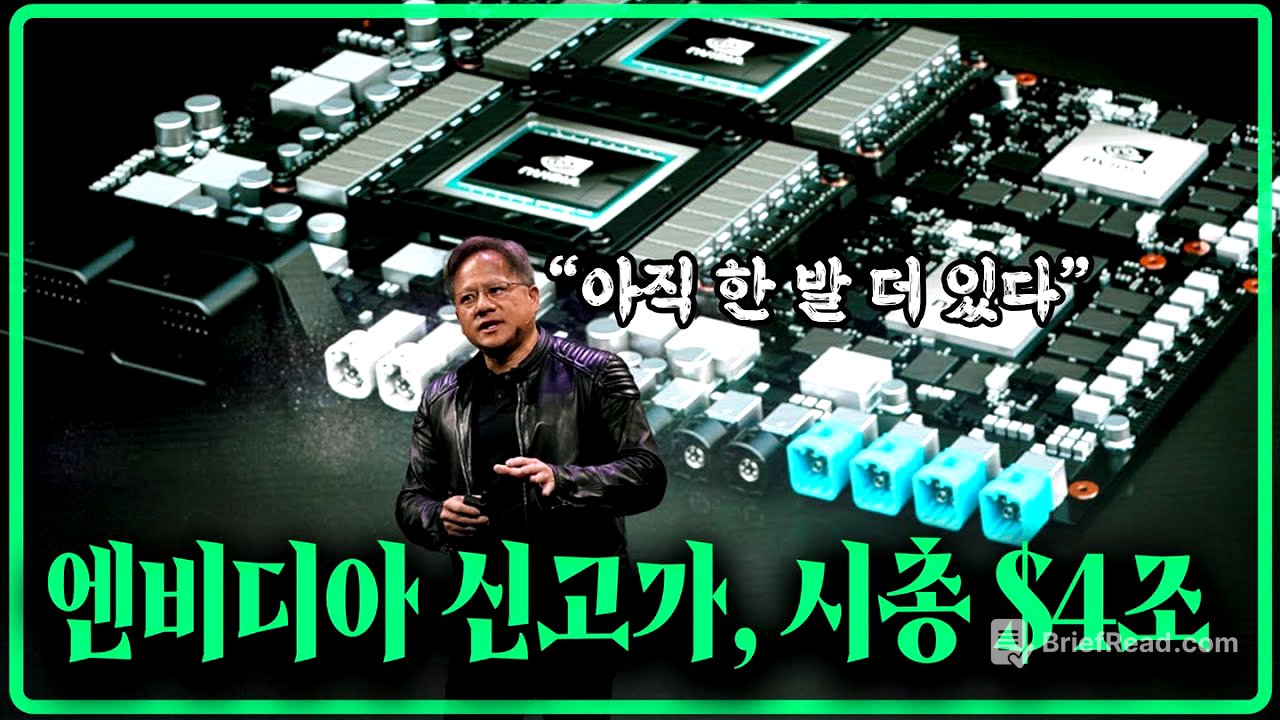TLDR;
The video discusses Nvidia's soaring market capitalization, surpassing $4 trillion and exceeding the economic size of some countries. It explores the geopolitical implications of GPU technology, comparing its importance to that of oil. The video also examines the complexities of AI chip trade between the US and China, including potential deals involving Nvidia chips for a data center in the Gobi Desert, and analyzes the apparent contradictions in statements from Nvidia and Huawei regarding AI chip capabilities.
- Nvidia's market cap has reached almost $4 trillion, exceeding the economic size of countries like England and France.
- The construction of a large data center in China's Gobi Desert raises questions about the source of the required 110,000 AI chips, given trade restrictions.
- Nvidia may be planning to launch a new AI chip specifically for China, potentially reviving previously written-off sales.
- GPU technology is becoming a critical geopolitical resource, comparable to oil in its strategic importance.
Nvidia's Market Cap and Global Economic Standing [0:00]
Nvidia's market capitalization has reached almost $4 trillion, surpassing the economic size of countries like England and France. This valuation exceeds the combined value of the bottom 220 companies in the SP Index and is enough to purchase every team in the NFL, MLB, and Premier League with significant funds remaining. The speaker emphasizes Nvidia's financial and technological dominance, highlighting its indispensable role in the tech industry.
The Gobi Desert Data Center and AI Chip Procurement [1:02]
A data center is being built in the Gobi Desert in Xinjiang, China, requiring 110,000 AI chips. The speaker questions the source of these chips, considering the restrictions on China's ability to purchase Nvidia chips and the limitations of Huawei's current chip production capabilities. It is unlikely that such a large quantity of chips could be procured through illicit trading networks.
Nvidia's Potential AI Chip Deal with China [2:38]
Nvidia plans to launch a new AI chip designed exclusively for China in September, with Chinese customers expressing interest in placing substantial orders. This development is connected to potential trade deals between the US and China, where the US may revise export regulations for AI chips. Nvidia had previously written off $4.5 billion for H20 chips intended for China, and a further $8 billion loss was reflected due to purchase agreement issues.
RTX Pro 6000D as a Solution for China [4:17]
Rumors suggest that the RTX Pro 6000D, modified for Chinese use, may be the chip delivered to China. This version uses Samsung's GDDR7 memory instead of HBM SK's high-bandwidth memory and employs regular packaging instead of TSMC's core packaging. While its performance is slightly lower than the H20, it allows Nvidia to generate additional sales in China without affecting existing production lines. Despite some performance degradation when combined, these chips are still valuable to Chinese developers who need Nvidia technology.
GPU Geopolitics and Nvidia's Strategy [6:06]
GPU technology is now a critical geopolitical resource, comparable to oil. Jensen Wang, Nvidia's CEO, believes China has almost caught up with the US in AI and has strategically used media to advocate for selling Nvidia chips to China, making them dependent on Nvidia's CUDA ecosystem. This strategy aims to ensure Nvidia's continued market presence and influence in China.
Contradictory Statements from Nvidia and Huawei [6:28]
There are contradictory statements from Nvidia and Huawei regarding AI chip capabilities. While American media reported that Huawei's Ascent chip was comparable to Nvidia's H100, Huawei's CEO stated that they are not yet at that level. This creates a paradoxical situation where both Jensen Wang and Ren Zhengfei are seemingly praising each other's chips, adding complexity to the understanding of the competitive landscape.
Nvidia's Target Price and Valuation [7:13]
Recent analysis has raised the target price for Nvidia, with an average target price around $180, suggesting about 10% room for growth. Despite the stock's rise, the forward price is only 28 times earnings, and the growth rate is expected to be over 50% next year. The speaker has consistently argued that Nvidia's valuation is cheap, similar to Apple's current situation but with a higher growth rate.









